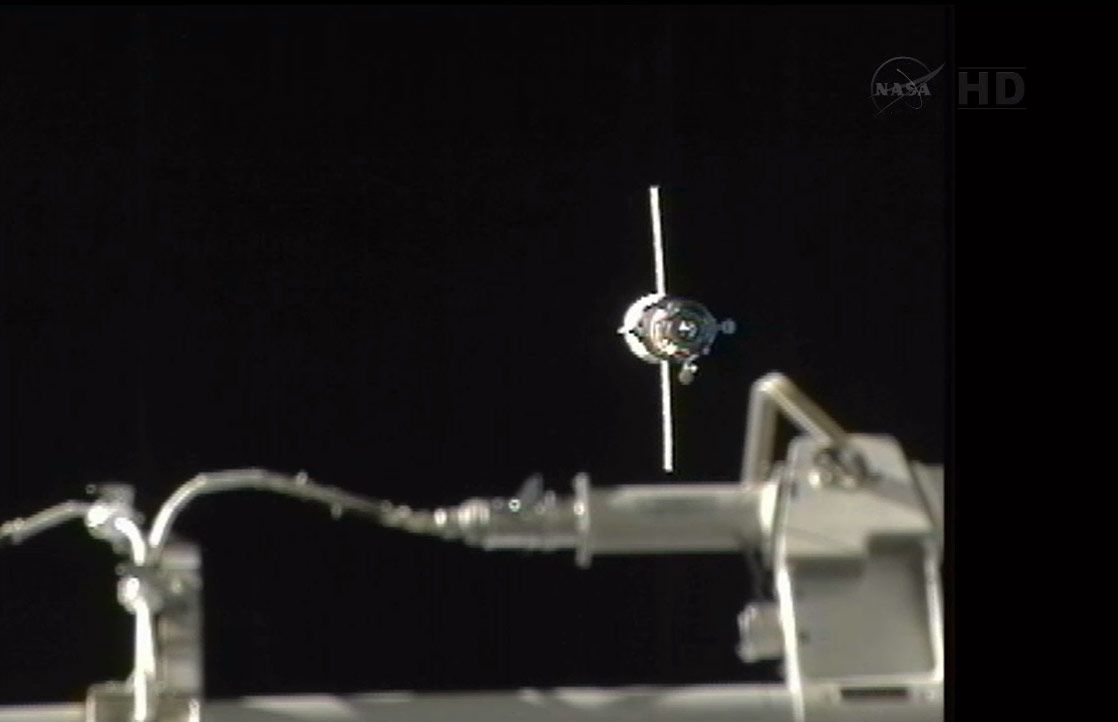Robotic Russian Supply Ship Docks With Space Station

An unmanned Russian spacecraft carrying nearly 3 tons of supplies arrived at the International Space Station Monday (Feb. 11) less than six hours after blasting off.
The robotic Progress 50 resupply ship docked with the orbiting lab at 3:35 p.m. EST (2035 GMT) Monday after launching from Baikonur Cosmodrome in Kazakhstan at 9:41 a.m. EST (1441 GMT). Such unmanned cargo trips have traditionally taken about two days.
The Progress 50 spacecraft is packed with about 2.9 tons of supplies for the space station's six-man Expedition 34 crew. On Saturday (Feb. 9), the station astronauts discarded an older unmanned cargo ship, called Progress 48, in order to make room for Progress 50.
The outgoing Progress vehicle was filled with tons of trash and unneeded items and intentionally destroyed by burning up in Earth's atmosphere. [Space Station's Robot Cargo Ship Fleet (Photos)]
Progress 50, meanwhile, is delivering about 764 pounds (346 kilograms) of propellant, 110 pounds (50 kg) of oxygen and air, 926 pounds (420 kg) of water and about 3,000 pounds (1,360 kg) of spare parts, science gear and other supplies, according to a NASA description.
The Russian Federal Space Agency's Progress spacecraft are disposable vehicles similar in design to its three-segment Soyuz crew capsules, but with a propellant module in place of the central crew return capsule on the Soyuz.
Progress vehicles are designed to be disposable and are intentionally ditched into Earth's atmosphere at the end of their mission. Robotic resupply ships for the station built by Europe and Japan are also disposed of in the same way.
Sign up for the Live Science daily newsletter now
Get the world’s most fascinating discoveries delivered straight to your inbox.
The only robotic supply ship for the space station that can return supplies back to Earth is the Dragon space capsule built by the private spaceflight company SpaceX.
Dragon space capsules visited the space station twice in 2012, with the next one slated to launch from Florida atop SpaceX's Falcon 9 rocket in March. Dragon vehicles are equipped with a heat shield to protect them during re-entry and are built for ocean splashdown landings in order to return experiments and other gear to Earth.
The space station's current Expedition 34 is commanded by NASA astronaut Kevin Ford. The other crewmembers are fellow NASA spaceflyer Tom Marshburn, Canadian Chris Hadfield and Russian cosmonauts Oleg Novitskiy, Evgeny Tarelkin and Roman Romanenko.
Hadfield will become the first-ever Canadian to command a station mission when he takes over Expedition 35, which will begin in March with the departure of Ford, Novitskiy and Tarelkin.
This story was provided by SPACE.com, a sister site to Live Science. You can follow SPACE.com Managing Editor Tariq Malik on Twitter @tariqjmalik. Follow SPACE.com on Twitter @Spacedotcom. We're also on Facebook & Google+.

Tariq is the editor-in-chief of Live Science's sister site Space.com. He joined the team in 2001 as a staff writer, and later editor, focusing on human spaceflight, exploration and space science. Before joining Space.com, Tariq was a staff reporter for The Los Angeles Times, covering education and city beats in La Habra, Fullerton and Huntington Beach. He is also an Eagle Scout (yes, he has the Space Exploration merit badge) and went to Space Camp four times. He has journalism degrees from the University of Southern California and New York University.











